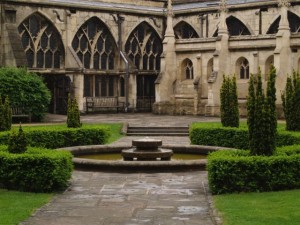Before we tackle the installation of the new altar, the iconostasis and the choir, we will need to deal with two tensions within monastic life. The first is transcendence versus immanence, and the second, closely related, is between cloister and hospitality. Let’s begin with the latter.

A cloister garden with central fountain and four walkways representing the four rivers of Eden. Courtesy geograph.org.uk
The cloister is the area of the monastery reserved for monks or nuns. It is the concrete sign of withdrawal from the world for the sake of the Kingdom of God. In the stronger parts of our tradition, the cloister is even equated with heaven, or at the very least, with a restored Garden of Eden. Cloisters have traditionally been built with four corners with a fountain at the center, embodying Genesis 2: 10-14. To enter the cloister requires the death and resurrection of monastic vows, and this death has frequently been indicated by the use of a funeral pall to cover the monk while the litany of saints is sung at his profession. Entrance into the cloister involves the renunciation of worldly thoughts, preoccupations, and behaviors, and the embrace of a holy life, even an angelic life, keeping watch like the sleepless angels and joining their constant praise of God in song.
One common misunderstanding of the symbolic value of the cloister conflates withdrawal from the world with mere privacy. Monks have nothing of their own, not even their wills, and so to imagine that the cloister is the private area of the monks where they can ‘be themselves’ and not bothered by guests is missing the point. Monks only leave the cloister (in theory) reluctantly, and out of obedience directed toward the welfare of the church. Nuns who practice papal enclosure almost never leave at all, for any reason. It is not because they “keep to themselves” or are unconcerned with the world. Rather, the world needs reminding that its values are not lasting, and that the things of the world are of value only as the open onto the ultimate realities of God’s coming reign. So the separate, cloistered lives of contemplatives are meant to model for the church and the world the transcendent values of Christ’s kingdom, not a retiring life in this world.
If the cloistered life requires this separation from the world, how is it that “monasteries are never lacking for guests?” In fact, the tension between cloister and hospitality only apparent. We monks and nuns certainly want to welcome others to share in the joy of serving God in the liturgy and in a life that focuses on constant prayer and gratitude. And so monasteries normally have areas for guests to stay and eat, and places where they can meet with the monks, if that is desirable (plenty of our guests in Chicago are happy with silence!). Clear boundaries make hospitality possible, even easy, since mutual expectations can be clear and all involved can relax in the confidence that we are together doing God’s will. Sometimes communities today allow guests more free access to the cloister. I can’t say whether or not this is a good practice in every case. In our particular case, it has not worked in the past because our cloister is so small that any compromise of it tends to flatten the sense of transcendence to which I referred above. Guests who have not undergone monastic formation usually don’t know how to comport themselves within the cloister in such a way as to maintain the atmosphere of prayer and recollection that is the goal of the separation from external anxieties.

Joseph Fiennes as Luther. After his gig as Shakespeare, opposite Gwyneth Paltrow, his rebound tossed him into the slough of despond opposite _deus absconditus_. If you aren’t into geeky theological jokes, just ignore me.
And if we monks are not able to maintain this sense of recollection, of God’s immanent presence in all things, we will not be able to communicate to others. And so we see how it can be that the apparent tension between transcendence and immanence is also only apparent, once properly understood. We need ways to symbolize God’s transcendence for ourselves so that His immanence does not become something bland and taken for granted. And we need ways of symbolizing His immanence that avoid taming God or reducing His presence to something this-worldly. God’s presence everywhere should be a routine surprise, and this requires an alertness and special discipline. The cloister is set up in such a way as to make this discipline possible.
I have mentioned in a couple of earlier posts that our monastery church is robustly ‘vertical’, and an emphasis on the verticality of the architecture means an emphasis on God’s transcendence. When theologians argue about God’s transcendence, there is commonly today a certain fearfulness that this majestic God will retreat into a faraway place, leaving us all but orphaned, anxiously sending up prayers in the blind hope that they will somehow reach him in spite of our feebleness. There is reason to think that this kind of theology was present, even dominant, in the Western Church from the end of the Middle Ages until recently (this is a very complex question!), and certainly the distance between God and ourselves has been felt by figures like Martin Luther and Cornelius Jansen. The reforms of the liturgy that began in the nineteenth century and culminated after Vatican II, were meant, in part, to address this imbalance.
And so when we began celebrating Mass facing the East and began talking about restoring the high altar, a few of our knowledgeable friends expressed concern, and understandably so. The task facing us as monks was to find a way to communicate, in symbol, the reality that a robust sense of God’s transcendence can very much be at the service of a joyful, felt experience of God’s loving and merciful nearness. This complementarity needs to be kept in mind as I describe, in the next few posts, how we came to commission our beautiful iconostasis, restore the high altar, and help design a new choir, installation of which begins today!